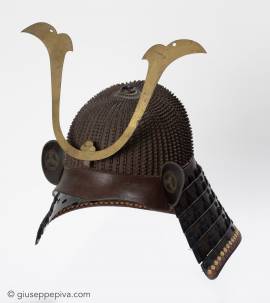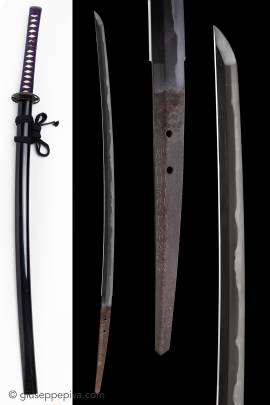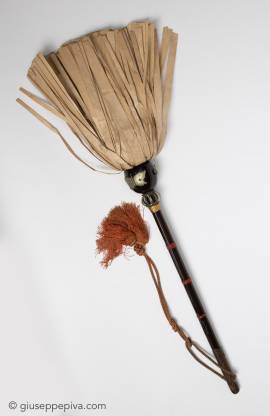Early Edo period (1615-1867)Haruta School, 17th centuryA 58-plate koboshi-bachi [helmet bowl with small standing rivets] of typical tenkokuzan form, with 30 pointed rivets on each plate decreasing in size towards the top, with the exception of the larger front plate, with three lines of rivets, for a total of 1,440 rivets.The tenkokuzan shape of this bachi, lower in the center and slightly higher on the back, is somehow more round than usual, referring the the akoda nari line from the medieval helmets.Although the helmet is unsigned, the...
WORKS FOR SALE
Early Edo Period (1615-1867), circa 1650Signed 肥前國河内大掾藤原正廣Hizen kuni kawachi daijō Fujiwara MasahiroNBTHK Hozon Tōken Nagasa [length]: 72 cmSori [curvature]: 1.4 cmMotohaba [bottom width]: 2.9 cmSakihaba [top width]: 2.1 cmMotokasane [bottom thickness]: 5.5 mm Sugata [configuration]: Shinogi-zukuri, iori-mune, koshi-zori, chu-kissakiKitae [forging pattern]: Ko-itame hada and konuka hada typical of Hizen. Jinie.Hamon [tempering pattern]: Gunome midare in nie-deki with thick nioiguchi. Ashi, yō, long sunagashi and kinsuji.Boshi [point]: Round at the end with hakikake kaeriNakago [tang...
Commander batonMid Edo Period (1615-1867)Wood with silvered-copper mounts and paperLength: 82 cm Born as a tool to control the troops, the saihai changed his function during the Edo period and became an accessory to wear with the armor as a symbol of power.The saihai's final can be in different materials; sometimes is applied directly to the stick, as in this case while some other time it hangs to a small rope. This saihai of uncommon large size and horizontal shape is inspired by western scepters. The baton is fitted with silvered applications representing some butterflies. A...
Copyright © 2016 - giuseppe piva - VAT: 05104180962










